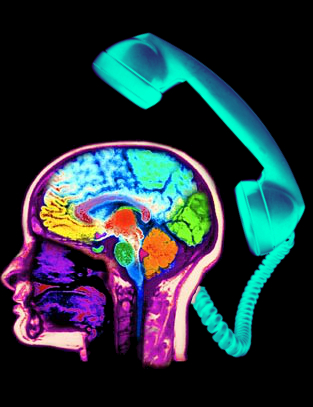Brain-to-brain email sends thoughts around the world
 A fascinating research project has seen two people send emails directly to each others’ minds.
A fascinating research project has seen two people send emails directly to each others’ minds.
Neuroscientists in Spain have developed a totally non-invasive system that allows the transmission of words to brains thousands of kilometres apart.
In a recent demonstration, they sent the words “hola” and “ciao” from India directly to the minds of three people in France.
The project expands previous studies using brain-computer and computer-brain interfaces, which can translate electrical activity of the cortex into digital bits, and vice-versa.
Words are encoded as a string of 1’s and 0’s and repeated seven times for redundancy.
The bits were presented one-by-one to a volunteer playing the role of the emitter, and he was asked to perform a simple task on a computer which would translate the data into thoughts.
The emitter had to imagine moving an animated ball to a target at the right of the screen with either his hands (for 1’s) or feet (for 0’s). The bit was successfully encoded if he managed to hit the target with the ball.
While this was happening, the electrical activity of his brain was recorded with EEG and then encoded with a brain-computer interface from brain waves into digital bits, and sent to Paris using email.
Three receiver volunteers were attached to Transcranial Magnetic Stimulation (TMS) to convert the digital signals back into manifestations in the brain.
When the coil of a TMS machine is placed above a certain part of the visual cortex, it produces flashes of bright light for the wearer, but they disappear when the coil is rotated 90 degrees. Thus, the flashes of light called ‘phosphenes’ can work as a binary code: the absence of phosphenes means 0, and their presence is decoded as 1.
Volunteers wore eye masks and earplugs to reduce external stimuli while receiving thoughts from the internet.
When the computer-brain interface received an email containing the transmitter’s neural code it read through the bits one-by-one, moving the TMS magnetic coil to the correct orientation so that the receivers saw phosphenes for 1’s and nothing for 0’s. The string of binary data was documented to compare against the original idea.
Words were successfully transmitted each of the two times the system was tested, with a remarkably low error rate of only 4 per cent for all the bits. But it is a painfully slow connection with an average speed of just 2 bits per minute.
While the e-brain system may seem like a needlessly complex version of high-tech Morse code, the recent tests represent the first time that direct brain-to-brain communication has been demonstrated in humans using fully non-invasive technology.
The project has been viewed by many as a mere gimmick - but even if such experiments never lead to useful clinical developments, it still stands as a reminder of the astounding and surprising possibilities in science.
The experiment is detailed in a report for the journal PLoS One.








 Print
Print